Engage NY Eureka Math Precalculus Module 4 Lesson 14 Answer Key
Eureka Math Precalculus Module 4 Lesson 14 Example Answer Key
Example 1.
A designer wants to test the safety of a wheelchair ramp she has designed for a building before constructing it, so she creates a scale model. To meet the city’s safety requirements, an object that starts at a standstill from the top of the ramp and rolls down should not experience an acceleration exceeding 2.4 \(\frac{\mathrm{m}}{\mathrm{s}^{2}}\) .
a. A ball of mass 0.1 kg is used to represent an object that rolls down the ramp. As it is placed at the top of the ramp, the ball experiences a downward force due to gravity, which causes it to accelerate down the ramp. Knowing that the force applied to an object is the product of its mass and acceleration, create a sketch to model the ball as it accelerates down the ramp.
Answer:
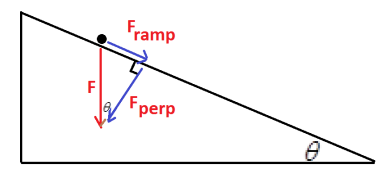
b. If the ball rolls at the maximum allowable acceleration of 2.4 \(\frac{\mathrm{m}}{\mathrm{s}^{2}}\), what is the angle of elevation for the ramp?
Answer:
Framp = mball×aball = 0.1 kg×2.4 \(\frac{\mathrm{m}}{\mathrm{s}^{2}}\) = 0.24 N parallel to the ramp and directed down the ramp
F = mball×agravity = 0.1 g×9.8 \(\frac{\mathrm{m}}{\mathrm{s}^{2}}\) = 0.98 N directed down toward the ground
sin (θ) = \(\frac{F_{\text {ramp }}}{F}\) = \(\frac{0.24 \mathrm{~N}}{0.98 \mathrm{~N}}\)
sin-1 (sin (θ)) = sin-1(\(\frac{0.24 \mathrm{~N}}{0.98 \mathrm{~N}}\)) ≈ 14.2°
The angle of elevation for the ramp is approximately 14.2°.
c. If the designer wants to exceed the safety standards by ensuring the acceleration of the object does not exceed 2.0 \(\frac{\mathrm{m}}{\mathrm{s}^{2}}\) , by how much will the maximum angle of elevation decrease?
Answer:
Framp = mball×aball = 0.1 kg×2.0 \(\frac{\mathrm{m}}{\mathrm{s}^{2}}\) = 0.2 N parallel to the ramp and directed down the ramp
F = mball×agravity = 0.1 g×9.8 \(\frac{\mathrm{m}}{\mathrm{s}^{2}}\) = 0.98 N directed down toward the ground
sin (θ) = \(\frac{F_{\text {ramp }}}{F}\) = \(\frac{0.24 \mathrm{~N}}{0.98 \mathrm{~N}}\)
sin-1 (sin (θ)) = sin-1 (\(\frac{0.24 \mathrm{~N}}{0.98 \mathrm{~N}}\)) ≈ 11.8°
The maximum angle of elevation would be approximately 11.8°, which is 2.4 degrees less than the maximum angle permitted to meet the safety specification.
d. How does the mass of the ball used in the scale model affect the value of θ? Explain your response.
Answer:
It doesn’t. The mass of the ball is a common factor in the numerator and denominator in the ratio used to calculate θ.
Example 2.
The declination of the sun is the path the sun takes overhead the earth throughout the year. When the sun passes directly overhead, the declination is defined as 0°, while a positive declination angle represents a northward deviation and a negative declination angle represents a southward deviation. Solar declination is periodic and can be roughly estimated using the equation
δ = -23.44°(cos((\(\frac{360}{365}\))(N + 10))), where N represents a calendar date (e.g., N = 1 is January 1, and δ is the declination angle of the sun measured in degrees).
a. Describe the domain and range of the function.
Answer:
D: 1 ≤ N ≤ 365 where N is a counting number
R: -23.44° ≤ δ ≤ 23.44°
b. Write an equation that represents N as a function of δ.
Answer:
δ = -23.44°(cos((\(\frac{360}{365}\))(N + 10)))
\(\frac{\delta}{-23.44^{\circ}}\) = (cos((\(\frac{360}{365}\))(N + 10)))
cos-1 (\(\frac{\delta}{-23.44^{\circ}}\)) = (\(\frac{360}{365}\))(N + 10)
-10+(365/360) cos-1 (\(\frac{\delta}{-23.44^{\circ}}\)) = N
c. Determine the calendar date(s) for the given angles of declination:
i. 10°
Answer:
N = -10+(\(\frac{360}{365}\)) cos-1 (\(\frac{10^{\circ}}{-23.44^{\circ}}\)) ≈ 107 and 238
N = 107 corresponds to a calendar date of April 17, and N = 238 corresponds to August 26.
ii. -5.2°
Answer:
N = -10+(\(\frac{360}{365}\)) cos-1 (\(\frac{-5.2^{\circ}}{-23.44^{\circ}}\)) ≈ 68 and 277
N = 68 corresponds to a calendar date of March 9, and N = 277 corresponds to October 4.
iii. 25°
Answer:
No date will correspond to this angle because it lies outside of the domain of the function.
d. When will the sun trace a direct path above the equator?
Answer:
When the sun passes directly overhead, the declination is 0°. This means that
N = -10+(\(\frac{360}{365}\)) cos-1 (\(\frac{0^{\circ}}{-23.44^{\circ}}\)) ≈ 81 and 264, which correspond to the calendar dates March 22 and September 21.
Eureka Math Precalculus Module 4 Lesson 14 Exercise Answer Key
Exercise 1.
A vehicle with a mass of 1,000 kg rolls down a slanted road with an acceleration of 0.07 \(\frac{0.24 \mathrm{~N}}{0.98 \mathrm{~N}}\) . The frictional force between the wheels of the vehicle and the wet concrete road is 2,800 newtons.
a. Sketch the situation.
Answer:
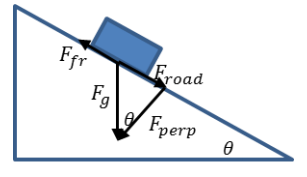
b. What is the angle of elevation of the road?
Answer:
Froad = mvehicle×avehicle+Ffr = 1000 kg×0.07 \(\frac{0.24 \mathrm{~N}}{0.98 \mathrm{~N}}\) = 70 N + 2800 N = 2870 N
Fgravity = mvehicle×agravity = 1000 kg×9.8 \(\frac{0.24 \mathrm{~N}}{0.98 \mathrm{~N}}\) = 9800 N
sin (θ) = \(\frac{F_{\text {road }}}{F_{\text {gravity }}}\) = \(\frac{2870 \mathrm{~N}}{9800 \mathrm{~N}}\)
sin-1 (sin (θ)) = sin-1 (\(\frac{2870 \mathrm{~N}}{9800 \mathrm{~N}}\)) ≈ 17°
The angle of elevation for the road is approximately 17°.
c. What is the maximum angle of elevation the road could have so that the vehicle described would not slide down the road?
Answer:
If the vehicle does not slide, then the frictional force must be greater than or equal to the downward force parallel to the road. So, for the maximum angle θ, Froad = Ffriction = 2800 N.
sin (θ) = \(\frac{F_{\text {road }}}{F_{\text {gravity }}}\) = \(\frac{2870 \mathrm{~N}}{9800 \mathrm{~N}}\)
sin-1 (sin (θ)) = sin-1 (\(\frac{2870 \mathrm{~N}}{9800 \mathrm{~N}}\)) ≈ 16.6°
The angle of elevation for the road that would prohibit sliding is approximately 16.6°.
Exercises 2–3
Exercise 2.
The average monthly temperature in a coastal city in the United States is periodic and can be modeled with the equation y = -8 cos((x-1)(π/6))+17.5, where y represents the average temperature in degrees Celsius and
x represents the month, with x = 1 representing January.
a. Write an equation that represents x as a function of y.
Answer:
x = 1+\(\frac{6}{\pi}\) cos-1 (\(\frac{y-17.5}{-8}\))
b. A tourist wants to visit the city when the average temperature is closest to 25° Celsius. What recommendations would you make regarding when the tourist should travel? Justify your response.
Answer:
x = 1+\(\frac{6}{\pi}\) cos-1 (\(\frac{25-17.5}{-8}\))) ≈ 6.32
If the tourist wants to visit when the temperature is closest to 25° Celsius, she should travel about the second week in June.
Exercise 3.
The estimated size for a population of rabbits and a population of coyotes in a desert habitat are shown in the table. The estimated population sizes were recorded as part of a long-term study related to the effect of commercial development on native animal species.

a. Describe the relationship between sizes of the rabbit and coyote populations throughout the study.
Answer:
The rabbit population started at approximately 15,000 rabbits and then decreased while the coyote population increased (perhaps because of the abundance of prey for the coyotes). Over time, both the rabbit and coyote populations declined until the coyote population was about 1,800, when the rabbit population increased again. Both species’ population numbers appear to cycle, with the coyotes’ values shifted about
3 years from the rabbit’s values.
b. Plot the relationship between the number of years since the initial count and the number of rabbits. Fit a curve to the data.
Answer:
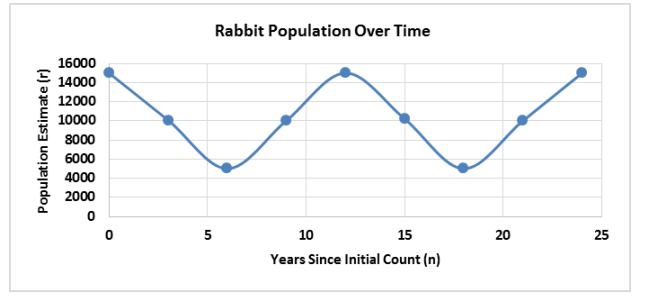
Equation of curve: r = 5000 cos(\(\frac{\pi n}{6}\))+10000
c. Repeat the procedure described in part (b) for the estimated number of coyotes over the course of the study.
Answer:

Equation of curve: c = 200 sin(\(\frac{\pi n}{6}\))+2000
d. During the study, how many times was the rabbit population approximately 12,000? When were these times?
Answer:
r = 5000 cos(\(\frac{\pi n}{6}\))+10000
n = \(\frac{6}{\pi}\) cos-1 (\(\frac{r-10000}{5000}\))
n = \(\frac{6}{\pi}\) cos-1 (\(\frac{12000-10000}{5000}\)) ≈ 2.2
Given that the function cycles every 12 years, n = 0 + 2.2 = 2.2; n = (12-2.2) = 9.8; n = (12 + 2.2) = 14.2; and n = (24-2.2) = 21.8. The rabbit population was approximately 12,000 four times at 2.2, 9.8, 14.2, and 21.8 years.
e. During the study, when was the coyote population estimate below 2,100?
Answer:
c = 200 sin(\(\frac{\pi n}{6}\))+2000
n = \(\frac{6}{\pi}\) sin-1 (\(\frac{c-2000}{200}\))
n = \(\frac{6}{\pi}\) sin-1 (\(\frac{2100-2000}{200}\)) = 1,5,13,17
By analyzing the graph of the coyote population estimates, the population of coyotes was less than 2,100 prior to n = 1, between n = 5 and n = 13, and from n = 17 to n = 24.
Eureka Math Precalculus Module 4 Lesson 14 Problem Set Answer Key
Question 1.
A particle is moving along a line at a velocity of y = 3 sin(\(\frac{2 \pi x}{5}\))+2 \(\frac{m}{s}\) at location x meters from the starting point on the line for 0 ≤ x ≤ 20.
a. Find a formula that represents the location of the particle given its velocity.
Answer:
y = \(\frac{5}{2 \pi}\)⋅sin-1(\(\frac{x-2}{3}\))
b. What is the domain and range of the function you found in part (a)?
Answer:
The domain is -1 ≤ x ≤ 5, and the range is –\(\frac{5}{4}\) ≤ y ≤ \(\frac{5}{4}\).
c. Use your answer to part (a) to find where the particle is when it is traveling 5 m/s for the first time.
Answer:
The particle will be located at x = 1.2 meters from the starting point on the line.
d. How can you find the other locations the particle is traveling at this speed?
Answer:
In this case, the velocity is a maximum, so it will only occur once every period. All other values can be found by adding multiples of 5 to the location. If it was not a maximum, we could subtract the location from 5/2 to find another value within the same period and then add multiples of 5 to find analogous values in other periods.
Question 2.
In general, since the cosine function is merely the sine function under a phase shift, mathematicians and scientists regularly choose to use the sine function to model periodic phenomena instead of a mixture of the two. What behavior in data would prompt a scientist to use a tangent function instead of a sine function?
Answer:
The tangent function has infinitely many vertical asymptotes and rapidly takes on extreme values. Since the tangent function is the ratio between the sine and cosine functions, it will probably show up when comparing the ratio of two sets of periodic data. Otherwise, the extreme values would be reasons to use the tangent function.
Question 3.
A vehicle with a mass of 500 kg rolls down a slanted road with an acceleration of 0.04 \(\frac{\mathrm{m}}{s^{2}}\) . The frictional force between the wheels of the vehicle and the road is 1,800 newtons.
a. Sketch the situation.
Answer:
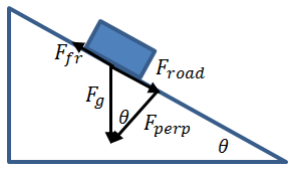
b. What is the angle of elevation of the road?
Answer:
Froad = ma + Ffr = 500 kg×0.04 \(\frac{\mathrm{m}}{s^{2}}\) + 1800 N = 20 N + 1800 N = 1820 N
Fg = mg = 500 kg×9.8 \(\frac{\mathrm{m}}{s^{2}}\) = 4900 N
sin(θ) = \(\frac{F_{\text {road }}}{F_{\mathrm{g}}}\) = \(\frac{1820 \mathrm{~N}}{4900 \mathrm{~N}}\)
sin-1 (sin(θ)) = sin-1 (\(\frac{1820 \mathrm{~N}}{4900 \mathrm{~N}}\)) ≈ 21.8°
The angle of elevation for the road is approximately 21.8°.
c. The steepness of a road is frequently measured as grade, which expresses the slope of a hill as a ratio of the change in height to the change in the horizontal distance. What is the grade of the hill described in this problem?
Answer:
We need to find the perpendicular force. We get
cos(21.8) = \(\frac{F_{\text {perp }}}{4900}\)
Fperp ≈ 4549.46.
So the grade of the hill is \(\frac{1820}{4549.46}\) ≈ 40%.
Question 4.
Canton Avenue in Pittsburgh, PA is considered to be one of the steepest roads in the world with a grade of 37%.
a. Assuming no friction on a particularly icy day, what would be the acceleration of a 1,000 kg car with only gravity acting on it?
Answer:
tan(θ) = 0.37
θ ≈ 20.30
Since the acceleration due to gravity is the only acceleration on the car, the acceleration due to gravity is being transferred into an acceleration as the car goes down the hill. We can envision the force due to gravity as two separate forces, one that is parallel to the road and the second that is perpendicular to the road. The force parallel to the road is F∥ = m⋅g⋅sin(θ), and the acceleration parallel to the road is
a = g⋅sin(θ)
a = 9.8 sin(20.3)
a ≈ 3.4
The acceleration is 3.4 \(\frac{\mathrm{m}}{s^{2}}\) .
b. The force due to friction is equal to the product of the force perpendicular to the road and the coefficient of friction μ. For icy roads and a non-moving vehicle, assume the coefficient of friction is μ = 0.3. Find the force due to friction for the car above. If the car is in park, will it begin sliding down Canton Avenue if the road is this icy?
Answer:
The force perpendicular to the road is 9191.3 N. F⊥ = m⋅g⋅cos(θ) = 1000⋅9.8⋅cos(20.3) ≈ 9191.3
Thus, the force due to friction is approximately 2757.4 N. μF⊥ ≈ 2757.4.
The force parallel to the road is 3400.0 N. F∥ = 1000⋅9.8⋅sin(20.3) ≈ 3400.0
Because the force parallel to the road is greater than the force due to friction, the car will slide down the road once Canton Avenue gets this icy.
c. Assume the coefficient of friction for moving cars on icy roads is μ = 0.2. What is the maximum angle of road that the car will be able to stop on?
Answer:
The car will be able to slow (and eventually stop) when the force due to friction is greater than the force parallel to the road, so we need to solve,
9800⋅sin(θ) = 0.2⋅9800 cos(θ)
\(\frac{\sin (\theta)}{\cos (\theta)}\) = 0.2
tan(θ) = 0.2.
So the car will be able to slow on any hill with less than a 20% grade, which corresponds to an angle of 11.3°.
Question 5.
Talladega Superspeedway has some of the steepest turns in all of NASCAR. The main turns have a radius of about 305 m and are pitched at 33°. Let N be the perpendicular force on the car and N_v and N_h be the vertical and horizontal components of this force, respectively. See the diagram below.
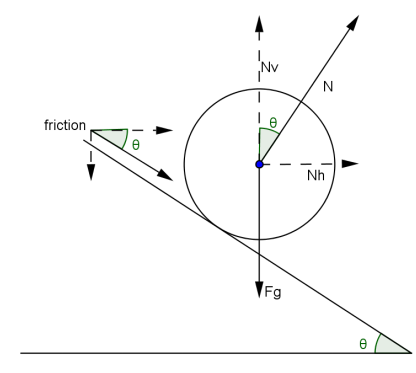
a. Let μ represent the coefficient of friction; recall that μN gives the force due to friction. To maintain the position of a vehicle traveling around the bank, the centripetal force must equal the horizontal force in the direction of the center of the track. Add the horizontal component of friction to the horizontal component of the perpendicular force on the car to find the centripetal force. Set your expression equal to (mv2)/r, the centripetal force.
Answer:
The force due to friction is μN, and the horizontal component then is μN cos(θ).
The horizontal perpendicular force would be N sin(θ).
We get, \(\frac{m v^{2}}{r}\) = N sin(θ)+μN cos(θ).
b. Add the vertical component of friction to the force due to gravity, and set this equal to the vertical component of the perpendicular force.
Answer:
N cos(θ) is the vertical component of the perpendicular force.
The force due to gravity is mg, and the vertical force of friction is μN sin(θ).
We get, N cos(θ) = mg + μN sin(θ).
c. Solve one of your equations in part (a) or part (b) for m, and use this with the other equation to solve for v.
Answer:
m = \(\frac{N \cos (\theta)-\mu N \sin (\theta)}{g}\)
\(\frac{N \cos (\theta)-\mu N \sin (\theta)}{g} \cdot \frac{v^{2}}{r}\) = N sin(θ)+μN cos(θ)
\(\frac{v^{2}}{g r}\) = \(\frac{N \sin (\theta)+\mu N \cos (\theta)}{N \cos (\theta)-\mu N \sin (\theta)}\)
We can factor out the N and cancel the common factor from here onward.
v2 = gr⋅\(g r \cdot \frac{\sin (\theta)+\mu \cos (\theta)}{\cos (\theta)-\mu \sin (\theta)}\)
v = \(\sqrt{g r \cdot \frac{\sin (\theta)+\mu \cos (\theta)}{\cos (\theta)-\mu \sin (\theta)}}\)
d. Assume μ = 0.75, the standard coefficient of friction for rubber on asphalt. For the Talladega Superspeedway, what is the maximum velocity on the main turns? Is this about how fast you might expect NASCAR stock cars to travel? Explain why you think NASCAR takes steps to limit the maximum speeds of the stock cars.
Answer:
v = \(\sqrt{g r \cdot \frac{\sin (\theta)+\mu \cos (\theta)}{\cos (\theta)-\mu \sin (\theta)}}\)
= \(\sqrt{9.8 \cdot 305 \cdot \frac{\sin (33)+0.75 \cos (33)}{\cos (33)-0.75 \sin (33)}}\)
≈ 90.3
90.3 m/s is about 202 mph, which is the speed most people associate with NASCAR stock cars (although they usually go slower than this). This means that at Talladega, the race cars are able to go at their maximum speeds through the main turns.
If the cars go any faster than this, then they would drift up toward the wall, which may prompt them to oversteer and possibly spin out of control. NASCAR may limit the speeds of the cars because the racetracks themselves are not designed for cars that can go faster.
e. Does the friction component allow the cars to travel faster on the curve or force them to drive slower? What is the maximum velocity if the friction coefficient is zero on the Talladega roadway?
Answer:
The friction component is in the direction toward the center of the racetrack (away from the walls), so it allows them to travel faster more safely. If μ = 0, the equation becomes v = \(\sqrt{g r \tan (\theta)}\). Therefore, the maximum velocity is about 44.1 \(\frac{\mathrm{m}}{\mathrm{s}}\) or 99 mph.
f. Do cars need to travel slower on a flat roadway making a turn than on a banked roadway? What is the maximum velocity of a car traveling on a 305 m turn with no bank?
Answer:
They need to travel much slower on a flat roadway making a turn than when traveling on a banked roadway. The normal force does not prevent the car from spinning out of control the way it does on a banked turn.
If θ = 0, then the equation becomes v = \(\). Therefore, the maximum velocity is about 47.3\(\frac{\mathrm{m}}{\mathrm{s}}\) or 106 mph, which is much slower than the velocity that cars can travel on the banked turns (202 mph).
Question 6.
At a particular harbor over the course of 24 hours, the following data on peak water levels was collected (measurements are in feet above the MLLW):

a. What appears to be the average period of the water level?
Answer:
It takes 13 hours to get from the first low-point to the second, and 13 hours to get from the first high-point to the second, so the average period is \(\frac{13 + 13}{2}\) = 13.
b. What appears to be the average amplitude of the water level?
Answer:
There are three areas we can examine to get amplitudes, from 1:30 to 7:30, 7:30 to 14:30, and 14:30 to 20:30. We get amplitudes of \(\frac{8.21-(-0.211)}{2}\) = 4.2105, \(\frac{8.21-(-0.619)}{2}\) = 4.4145, and \(\frac{7.518-(-0.619)}{2}\) = 4.0685. We get 4.231 as the average amplitude.
c. What appears to be the average midline for the water level?
Answer:
3.748
d. Fit a curve of the form y = A sin(ω(x-h))+k or y = A cos(ω(x-h))+k modeling the water level in feet as a function of the time.
Answer:
Since it would make our curve more inaccurate to guess at what point the water levels will cross the midline, we can either start at 1:30 or 7:30 and use the cosine function. For 7:30, we get
y = 4.231 cos(\(\frac{2 \pi}{13}\) (x-7.5))+3.748.
e. According to your function, how many times per day will the water level reach its maximum?
Answer:
It should reach its maximum levels twice a day usually, but there is the rare possibility that it will reach its maximum only once.
f. How can you find other time values for a particular water level after finding one value from your function?
Answer:
The values repeat every 13 hours, so immediately once a value is found, adding any multiple of 13 will give other values that work. Additionally, if you have the inverse cosine value for a particular water level (but have not solved for x yet), then take the opposite, solve normally, and you will have another time to which you can add multiples of 13.
g. Find the inverse function associated with the function in part (d). What is the domain and range of this function? What type of values does this function output?
Answer:
y = \(\frac{13}{2 \pi}\) cos-1(\(\frac{x-3.748}{4.231}\))+7.5
The domain is all real numbers x, such that -0.483 ≤ x ≤ 7.979, and the range is all real numbers y such that 7.5 ≤ y ≤ 14.
Eureka Math Precalculus Module 4 Lesson 14 Exit Ticket Answer Key
Question 1.
The minimum radius of the turn r needed for an aircraft traveling at true airspeed v is given by the following formula
r = \(\frac{v^{2}}{g \tan (\theta)}\)
where r is the radius in meters, g is the acceleration due to gravity, and θ is the banking angle of the aircraft. Use
g = 9.78 \(\frac{\mathrm{m}}{s^{2}}\) instead of 9.81 \(\frac{\mathrm{m}}{s^{2}}\) to model the acceleration of the airplane accurately at 30,000 ft.
a. If an aircraft is traveling at 03 \(\frac{m}{s}\), what banking angle is needed to successfully turn within 1 km?
1000 = \(\frac{103^{2}}{9.78 \cdot \tan (\theta)}\)
θ = tan-1(\(\frac{103^{2}}{1000 \cdot 9.78}\))
≈ 47.328
About 47.3°
b. Write the formula that gives the banking angle as a function of the radius of the turn available for a fixed airspeed v.
Answer:
θ = tan-1(\(\frac{v^{2}}{r \cdot g}\))
c. For a variety of reasons, including motion sickness from fluctuating g-forces and the danger of losing lift, many airplanes have a maximum banking angle of around 60°. Does this maximum on the model affect the domain or range of the formula you gave in part (b)?
Answer:
If the angle cannot be greater than 60°, then the range caps out at 60° instead of normally being able to go up to 90°.